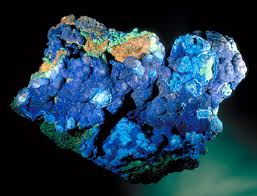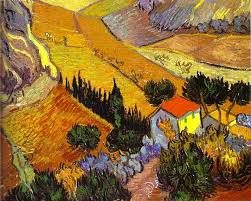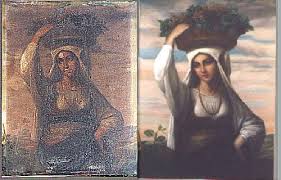A THREAT TO CULTURE? Art as craft, life and tradition
As a boy I used to spend hour after hour at a desk crammed into the entry hall of my childhood home, painstakingly creating one colored ink drawing after another. Aside from reading, drawing and painting was my favorite pastime, probably because such activities allowed me to enter a realm beyond "reality". A virtually limitless universe where I shared everything with everyone, but which nevertheless, at the same time and in all its vastness belonged to me and me alone. Sports have not interested me, perhaps because they are too tied up to reality, though I have always liked to run in the woods. It's probably lucky for me that there were no video games when I was young.
Among my retrieved drawings I found, some I made during drawing classes at school, including a booklet about color manufacture. The task consisted of not writing any text at all, only making instructive and imaginative illustrations. It surprised me that I had been able to accomplish something that from my current point of view was quite good; rather ingenious pictures demonstrating how colors had been produced from soil, lice and rocks. A feeling similar to the one I have described in an earlier blog post came over me - the boy who made these drawings had been a completely different person than the one I am now, but he and I are nevertheless identical. A kind of vertigo seized me; a sense of lack of limitations, like the world we encounter in art and literature, where masters of the past live on through the results of their labor and continue talk to each other, while they at the same time are directing themselves to me.
The thought that occupied my mind while I in an all-pervading downpour trudged to school was art as part of an infinite universe; a living, breathing organism obtaining its nourishment from every conceivable source. Refreshing as a crystal clear mountain lake with cold, tasty, and refreshing water.
While I sat in the staff room with the day's first cup of coffee and the morning paper in front of me, I read an article "The threat to a free culture" referring to the Sweden Democrats´ members of the Governmental Culture Committee and their party's views on culture. The image of the Sweden Democrats has forced its parliamentary members to tone down what earlier was a conspicuous hostility towards "culture", except the "national heritage". Party members now point out that "heritage is in greater need of support than contemporary art." Rather than attaching themselves to a canon of traditional "fine arts", the culture gurus of the Sweden Democrats apply an "anthropological" definition inspired by “autochthonous” traditions. A view reflected in the party program which hails "shared norms and values, collective memories, common myths, common celebrations and traditions" which unite us Swedes in the peace and joy of the Great Hall of The People´s Home.

In 1928, the Social Democrats launched the catch-word “People´s Home” as a symbol of "a good and stable home for all Swedes, built on democracy´s solid ground." With the expression “all Swedes” the Social Democrats meant that The People´s Home was meant to include people from all social classes, everyone ought to contribute to and benefit from a just society. While pilfering the Social Democrat´s slogan the Sweden Democrats stress “Swedish”, an approach that undeniably emits a whiff of National Socialism.
I shudder at the thought and recall a few lines from Gunnar Ekelöf´s poem Till de folkhemske, “To the Frightening Homely”, a wordplay indicating that the Swedish noun hem, “home” can be made into an adjective hemsk, meaning “frightening”: "Svea, the hormone queen carefully guarded by confident bouncers". "Common norms", “common values”, “common traditions”, what are the Sweden Democrats hinting at? Common for whom? Sweden Democrats? Inhabitants of Bjärnum? World Citizens? The emergence of such restrictive, limiting threats to culture worries me. I have understood culture as something full of opportunities, wide open in all directions. A sea to sail in, not a stagnant pool dammed up and poisoned by parochial grumblers.
"Culture" means cultivation and monoculture is not a particularly sustainable and healthy form of agriculture. The Sweden Democrats´ biologically determined characterization of something they call "the Swedish cultural heritage", which apparently is threatened by a multicultural bacterial growth, is in my opinion pure rubbish. It seems as if the Sweden Democrats are opening up a musty-smelling closet, releasing a stench of the rotting Blut und Boden (blood and soil) ideology that brought Germany into the abyss, and threatened Sweden with its ideological venom.

While I was pondering at the concepts of art and culture I was once again caught by an insistent urge to write a blog post. During a free period I searched my computer files for a text I wrote a few years ago. It was about colors and their origin. I wrote it after speaking with an Italian friend of mine, Marvi, who at the time worked with restoring antique paintings. I was fascinated by her stories and wrote down some insights gained from of our conversation.
When I came home from school, I found thetext among my old data files. Marvi had told me that restoration work was much more complicated than I had imagined. This meant not only trying to restore a painting to the condition it was assumed to be when it was completed. Every detail of its current condition had to be examined and its history traced. Where did the canvas come from? Where and by whom was it made? How is the state of the material, what does it consist of? Where did the colors come from? Were they perhaps made in the artist's own studio? Were they maybe manufactured locally by a chemist, or did they come from a company in Milan, or Paris? What kind of varnish was used? Was the canvas prepared in different layers, the paint applied in different sequences? Questions are many, the possibility of materials and technologies which were used is almost incalculable.
It does not become any easier while dealing with modern art, sometimes it is even more complicated. What do you, for example, do with a collage of the Futurist painter Carlo Carrá produced in 1914, consisting of a multitude of small pieces of paper cuts from newspapers, cardboard pieces and other things, which furthermore in several places are painted over with different kinds of paint, like pastels, oil and water colors? The whole thing is worth millions, but the glue has in several places penetrated the paper cuts, the newspaper clippings have yellowed and become extremely fragile, some of the colors have faded; pieces of paper have fallen off. It is almost impossible to restore the original appearance of the masterpiece, when the newsprint was new and white, the colors brilliant and all the paper pieces in place. It is important to identify the original newspapers Carrá made use of, to find out what kind of glue he applied, where the color came from, etc. etc. What took Carrá a day or two to make, may take more than a year of hard work to reconstruct and the result will nevertheless never be the same as the piece Carrá made exactly one hundred years ago.

Carrá´s work is far from being the most difficult example of restoration challenges. Prampolini, another futurist, used in his portraits pieces of yarn, thread rollers, sandpaper, and a varied mix of colors. Often it gets even worse the closer we come to our present time and encounter materials like plastic and latex, ingredients that are likely to become discolored or crack over time and several contemporary artists are inclined to use a variety of other materials, which in the future might be extremely difficult to trace and reconstruct.
For example, how about the possibilities of restoring a Piero Manzoni's masterpieces, like his series of 90 tin cans produced in 1961? Each can equipped with an informative label: Artist's Shit, Contents 30 gr net, Freshly preserved, Produced and tinned in May 1961. The text is printed in Italian, English, French and German. The cans have now begun to rust, while the labels are faded and discolored, some are damaged by moisture and are loosening from the cans. The state of the content remains unknown. Many owners of these artworks are willing to have them restored for considerable amounts of money and this is maybe not particularly strange. A not very well preserved can was in May 2007 sold for the price of 124,000 euros at Sotheby's in London, the price and demand are assumed to increase as more and more cans are losing their mint condition.

Marvi´s work did not consist so much of the restoration of modern art works; it was primarily provided by another group of experts at the firm where she worked. Marvi mostly occupied herself with the restoration of antique Italian paintings and was thus forced to identify and analyze various local soils which the artists had made use of when they produced colors of their own. For a successful restoration of an older, Italian oil- or tempera painting, it is important to find out what kind of soil the artists have used to produce, for example, their yellow or red ocher, their raw or burnt umber. From which location in Tuscany or Umbria had the earth been dug up? How and where had it been prepared and transformed into shades of red or brown? Had pigments been mixed and bound together by something other than oil of nuts, flax, cotton or poppy? Where there traces of starch, egg white, bone glue, fig latex, Armenian clay, wax, resin, lead, tin, casein, turpentine, or potash?
Marvi made me look at art with new eyes. Artists´ studios turned into alchemist laboratories where substances where bubbling and boiling within bowls and retorts, subjected to flames of fire, which transformed lead, tin, arsenic and mercury into dazzling colors.

Thousands of years of trial and error created remarkable recipes for the preparation of valuable dyes and colors. Like the yellow color euxanthin, which as early as in the Middle Ages was imported from India, where it was made from the urine of cows fed with mango leaves and spring water. A reddish-purple color came from insignificant Mediterranean snails, which in small quantities exuded yellowish, gray secretions, successively changing color from green to blue, finally turning into the coveted purple hue. The stunning red color in Venetian paintings, called cinnabar, vermillion or red lead, was originally a deadly dangerous, mercurial mud taken from the Spanish River Minio. The green malachite came in minced form from mines in Afghanistan. Lapis lazuli came from Tibet. Black came from the ivory burned in the interior of Africa. Before an even stronger , reddish color had been discovered in Mexico, the crimson color was transported along the Silk Road all the way from China, where it was made from Kermes, an unassuming but intensely red aphid. After Colombus had discovered the sea route to America, Chinese crimson was gradually replaced by shiny carmine dye produced from the cochineal bug, cultivated on a special cactus in Mexico. The green color vertegraz came from precious malachite or copper sulphate mixed with arsenic, one variant was called Parisian green since it was used for killing rats in Paris´ sewers.

Of course, such color exclusivities were expensive and difficult to come by, especially if an artist did not have the good fortune to count upon the support of an extremely wealthy patron. Accordingly, in virtually every artist's studio everything expected to produce cheap, but resistant and shining colors was boiled, dried, distilled and blended. Even close to home, there were bright red shield lice and just like the expensive kermes bugs they could produce paint if pregnant females were drained in vinegar and then dried and grounded to the sought-after red paint. Red could also be obtained from Italian soils, from copper sulfate and mercuric sulfide. Black came from charred pig bones, wine creepers or fatty soot from oil lamps. White calsomine was made by mixing slaked lime with milk, white lead paint by hanging lead sheets above trays with vinegar and then scraping off the white coating that had been formed. Green sand, or glauconite, was an iron potassium phyllosilicate found on the river banks. Azurite, or Egyptian blue, was obtained by grinding together sand, copper sulfate and bicarbonate. Plants such as indigo and woad gave blue color, mignonette and saffron yellow, a color that also could be extracted from lead, tin or arsenic.

If combined with skills and creativity these home-manufactured colors could be combined into exquisite works of art. In the Middle Ages and the Renaissance, an artist´s studio especially if it belonged to a well-known artist, was for the master´s journeymen as much a chemical laboratory and workshop, as a place to learn how to paint. The masters´ experimented with a variety of ingredients to provide their colors with glow and exclusive peculiarities, and their helpers and apprentices worked hard and long to produce and develop the different mixtures.
Contemporary restoration experts trace the masters´ techniques and ingredients in their attempts to reconstruct Cimabue´s and Duccio´s unique shades of color; their exclusive brown, gold and red. The origins of Titian's various shades of red are examined and so is the blue in Michelangelo´s drapes.

Shades and hues in the work of the genial Parmagianino are analyzed and it becomes apparent why that particular artist gained a reputation of having lost himself and his art in alchemical ruminations. The discovery of cobalt, chromium, cadmium yellow and emerald green through chemical processes and ready-made oil paints revolutionized the art; enabling masters like Cezanne and Van Gogh to experiment and on their own accomplish their masterpieces.

Commercial production of oil paint is a relatively new phenomenon. It began in France in 1720 when Lefranc & Bourgeois started to market large-scale produced colors, but for a long time after that several artists´ studios continued to give an impression of being alchemical laboratories, where the master and his pupils produced home-made and often deadly decoctions to be applied to meticulously prepared canvases.
Social changes intervened in these circumstances. In the 1700s, the artists´ guilds began to dissolve and the tradition of keeping young apprentices for the production of colors and the meticulous preparation of canvases was successively vanishing. Consequences could be disastrous, for example, masters´ disciples had previously prepared the oil paintings by applying a coat of paint grinded in slowly drying oils, afterwards the master himself painted layer after layer of paint which had been grinded with thinner and thinner oils. Over time, however, increasingly independent and solitary artists became tired of carefully preparing their canvases and dismissed the slow-drying oils. Soon, they made quite contrary to the prevalent tradition of craftsmanship, meaning that they laid the foundation with fast-drying, light oils and then successively worked with thicker and wetter oils, a procedure that eventually caused many oil paintings from the eighteenth and nineteenth centuries to crack and becoming hopelessly stained and darkened. Furthermore, several artists refrained from grinding the color pigments in "black oil", a mixture of linseed oil and lead oxide and instead mixed the pigments directly into the oil, the result has in many cases been catastrophic.

Grinding color is a complicated process involving pouring a boiling oil mixture (generally lin-seed oil) onto small amounts of color pigments, gently stirring it all together with a spatula, and then carefully grind the mixture together with the help of a "runner", a seven-pound stone. A slow, heavy and dull work, but if ignored it would mean that the pigment would not be grinded in such a way that the oil enclose each tiny grain of pigment.

All this means that art is far from being something created by a spur of the moment. In a way everything in our world is part of a long evolution that includes elements from every corner of the world and every phase of human evolution and ingeniousness, a process of trial and error continuing from generation to generation, developed during times when there was little difference between art and science, craft and artistic activities.
Everything is connected; art is an ocean, a universe of crafts, science, fancy, genius, catastrophic failures and astounding successes. For all this to be achieved, openness and diversity are essential requirements. Every splash of color on a canvas is the result of a long chain of hard work; of global contacts and scientific progress. In art, one can certainly not apply limits and controls, it is eternal and limitless. It is intimately connected with the infinitely large and the infinitely small; with man and woman, life, death and the universe. Art is neither clean nor contaminated. It's like you and me, the earth and the universe. It cannot be walled in by national borders, or specific characteristics. It cannot be controlled, not engulfed by taste and ideology. It cannot be contained by "common norms and values, collective memories, common myths, common celebrations and traditions," it is much, much greater than that.


Fuga, Antonella (2004) Technici e materiale delle arte. Milano: Electa. Gilmour, John (2011) Sweden, the Swastika and Stalin: The Swedish experience in the Second World War. Edinburgh: Edinburgh University Press.






.jpg)